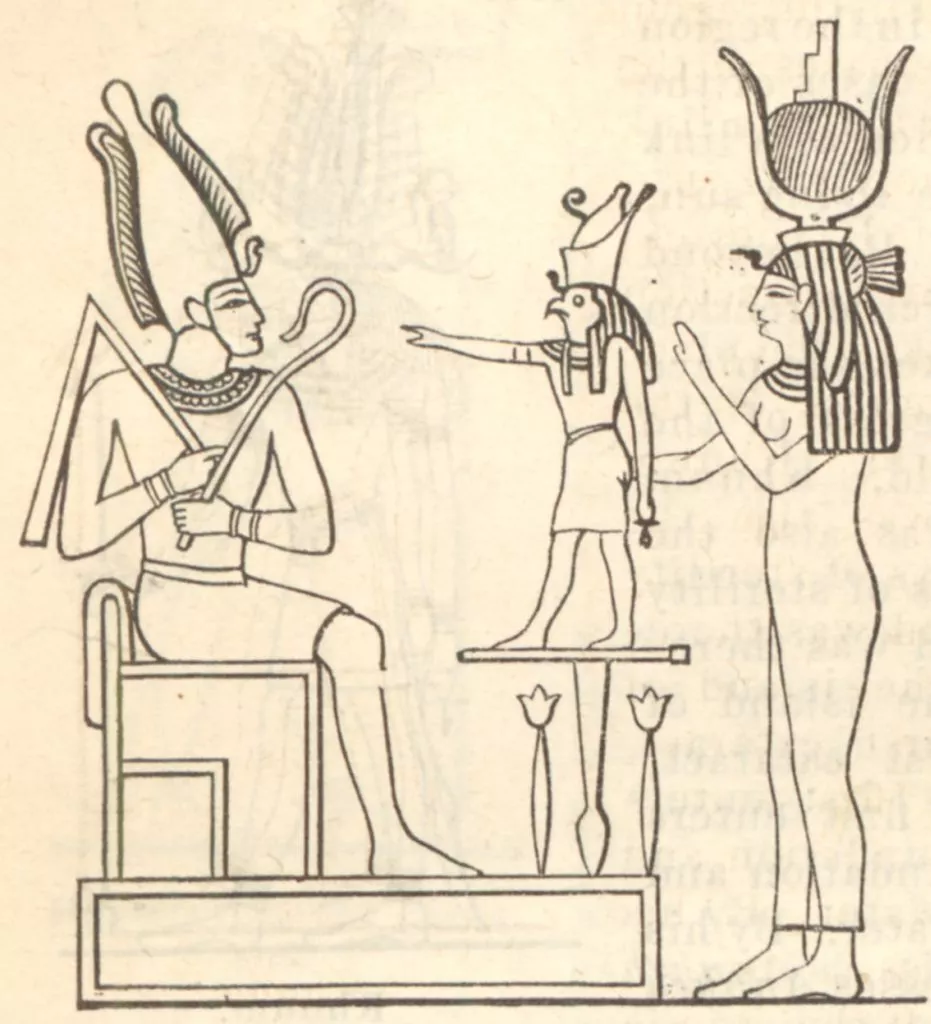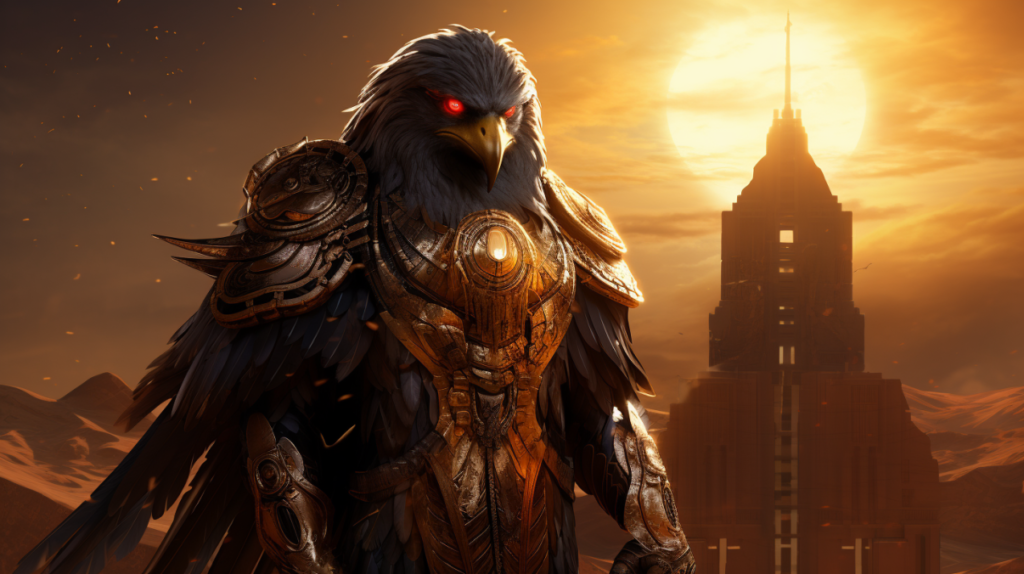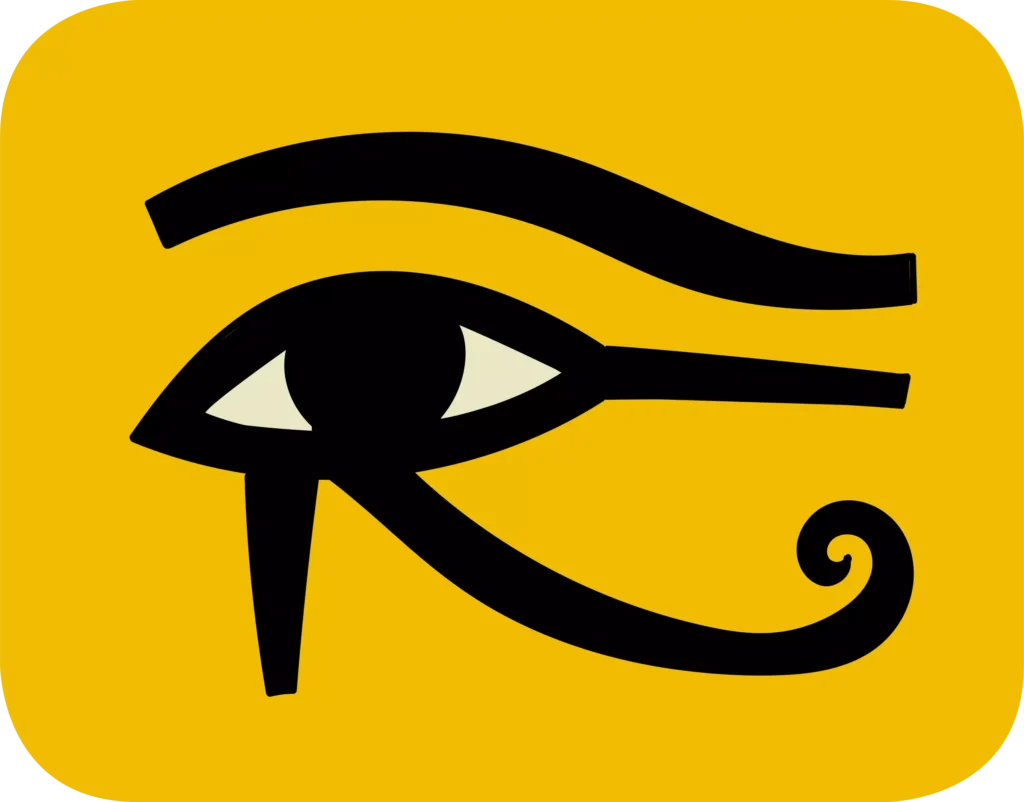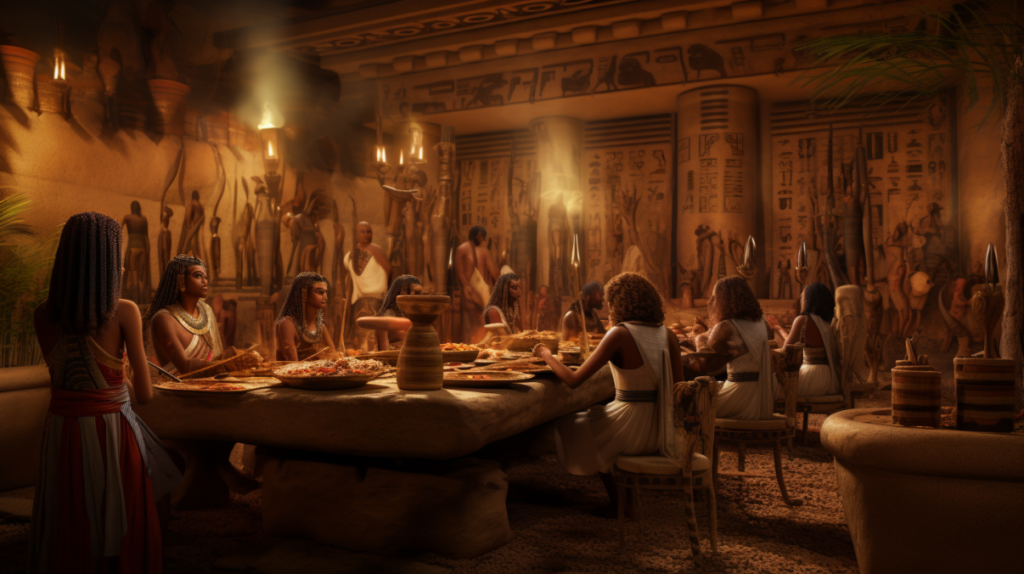In the grand tapestry of ancient Egyptian mythology, few figures shine as brightly as much reverence as the god Horus. His tale, woven through the epochs, encapsulates power, and a divine lineage that shaped the very essence of Egyptian civilization. As the god of the sky, kingship, and protection, he embodies the symbiotic relationship between the divine and mortal realms.
Horus emerges from the labyrinthine depths of Egyptian mythology, his inception embedded in the timeless clash between order and chaos. Born to the goddess Isis after the tragic demise of his father Osiris, Horus’s tale embodies resilience and retribution. This mythological genesis sets the stage for Horus’s ascendance as a god revered for his unwavering dedication to justice and protection.

Horus stands as an emblematic force, intertwined with the very essence of kingship and sovereignty. Revered as the patron deity of the pharaohs, he symbolizes not just divine authority but the cyclical nature of life, embodying the union between the mortal ruler and the divine realm. Horus’s significance extends beyond myth and permeates the cultural fabric, shaping the ideological underpinnings of Egypt’s social structure and reinforcing the divine right of kings.
Iconography surrounding Horus abounds with potent symbols reflective of his multifaceted nature. The most iconic representation is the falcon, symbolizing his celestial dominion and keen perception. The “Eye of Horus,” an ancient Egyptian symbol of protection and healing, encapsulates his omnipresent vigilance and benevolent guardianship. Additionally, the “udjat” or the Eye of Ra, intricately linked to Horus, embodies both lunar and solar energies, signifying his role as a unifying force balancing cosmic forces.
Through these symbols, Horus transcends the realms of mythology, etching his presence in art, architecture, and spiritual practices, perpetuating his legacy throughout the annals of ancient Egyptian history.

Horus embodies regality and divine grace, often depicted as a falcon-headed deity, a symbol of keen vision and cosmic authority. His countenance exudes both strength and wisdom, with piercing eyes that symbolize vigilance and foresight. Adorned with the double crown, signifying rulership over Upper and Lower Egypt, Horus stands as a paragon of sovereignty and cosmic balance. His physical representation mirrors the convergence of the avian and human, an embodiment of the divine in tangible form.
As a deity of multifaceted prowess, Horus commands a spectrum of extraordinary abilities. Foremost among his powers lies his mastery over the skies, embodying the celestial realm and overseeing the cycles of the sun and moon. His divine mandate extends to protection and divine justice, wielding his authority to safeguard both mortals and the pantheon from malevolent forces. Renowned for his martial prowess and strategic acumen, Horus embodies valor in battles against chaos and disorder, showcasing resilience and unwavering determination.
Horus navigates the intricate web of Egyptian mythology as a central figure, occupying a pivotal role in the divine hierarchy. As the son of Osiris and Isis, his familial ties intertwine with complex narratives of succession and cosmic order. He embodies the vengeful avenger seeking retribution for his father’s unjust demise at the hands of Set, the embodiment of chaos. Beyond familial relations, Horus assumes a multifaceted persona within the pantheon, serving as the protector of the pharaohs, the champion of justice, and the celestial arbiter preserving ma’at, the cosmic balance.
Within the divine realm, Horus forms alliances with other gods, forging bonds that reinforce the cosmic order. His dynamic relationships, especially with Isis, Thoth, and Ra, underscore his multifaceted role in the pantheon, aligning with various deities to uphold harmony and protect the divine framework that sustains the universe.
One of the most pivotal myths surrounding Horus revolves around his conflict with Set, the god of chaos. This epic saga encapsulates a struggle for supremacy and cosmic order. Set, envious and power-hungry, seeks dominion over Egypt and challenges Horus’s rightful claim to his father Osiris’s throne. The ensuing battle spans various episodes, including confrontations before the divine tribunal and skirmishes where Horus showcases his valor and divine prowess.
The myth details a significant trial where the gods convene to settle the dispute between Horus and Set. Thoth, the god of wisdom, presides over the tribunal. Among the notable events is the loss and restoration of Horus’s eye, which had been damaged during the conflict. The “Eye of Horus,” a symbol of protection and healing, becomes emblematic of the power struggle and eventual restoration of cosmic balance.

Horus’s quest to claim his rightful inheritance as the ruler of Egypt forms a central motif within his myths. His divine lineage as the son of Osiris and Isis imbues him with the inherent right to kingship. Through cunning, valor, and divine intervention, Horus overcomes adversities, asserting his claim to the throne. His ascendance solidifies the symbiotic relationship between the divine and mortal realms, establishing the blueprint for pharaonic rule and reinforcing the concept of Ma’at, the cosmic order.
While not solely focused on Horus, the myth of Osiris’s death and resurrection profoundly shapes Horus’s journey. Horus’s dedication to avenging his father’s murder by Set illustrates his unwavering commitment to justice and familial duty. This myth underscores Horus’s role as the divine avenger, driving him to confront adversity and restore cosmic harmony through his actions.
Worship of Horus permeated various facets of ancient Egyptian society, with rituals and ceremonies dedicated to honoring his divine presence. Temples dedicated to Horus served as focal points for religious practices. Offerings of food, incense, and symbolic items were presented to invoke his favor and protection. Ritualistic prayers and hymns extolled his virtues, seeking blessings for guidance, protection, and prosperity. Devotees often sought the intercession of Horus for matters of justice, healing, and safeguarding against malevolent forces.
The ancient Egyptian calendar was punctuated with vibrant celebrations honoring Horus, reinforcing his significance within the religious and cultural tapestry. One such notable festival was the “Feast of Horus,” a jubilant occasion marked by processions, offerings, and ceremonies held in his honor. These festivities not only celebrated his divine attributes but also emphasized the link between the pharaoh’s authority and Horus’s divine kingship. The “Festival of the Beautiful Reunion” was another notable event commemorating the reconciliation between Horus and Set, symbolizing the restoration of cosmic harmony and the triumph of order over chaos.

In modern spirituality, Horus retains a resurgent appeal. His embodiment of protection and vigilant guardianship finds resonance in contemporary interpretations of divine energies. Practices involving spiritual protection, inner strength, and clarity of vision often draw inspiration from Horus’s symbolism, showcasing his enduring relevance in guiding spiritual seekers.
Horus’s mythic narrative of justice prevailing over chaos resonates deeply in current discourse. His story serves as a powerful metaphor for overcoming challenges, seeking justice, and restoring balance in a world fraught with discord and turmoil. His tale inspires themes of resilience, justice, and the triumph of good over adversity, offering guidance and inspiration to individuals navigating life’s complexities.
References to Egyptian mythology, including Horus, abound in modern media. His iconic imagery, particularly the Eye of Horus, remains a potent symbol depicted in literature, movies, video games, and art. These representations perpetuate Horus’s significance, highlighting his role as a timeless emblem in pop culture, representing protection, healing, and spiritual insight.
While direct worship practices from ancient Egypt have transformed, the essence of Horus endures. Contemporary spiritual seekers may not follow traditional rituals, but Horus’s influence persists in nuanced ways. The symbolic resonance of Horus as a guardian and symbol of justice continues to shape modern spiritual beliefs and practices.
Horus, as a symbol of divine kingship and cosmic balance, transcends temporal boundaries. His story continues to inspire discussions on justice, order, and the eternal struggle between chaos and harmony. His presence in contemporary thought underscores his timeless relevance in shaping perceptions of societal balance and spiritual harmony in the modern world.
In our journey through ancient Egyptian mythology, Horus emerges as a timeless figure embodying vigilance, strength, and cosmic balance. From his mythical origins as an avenger to his role as a symbol of kingship, Horus’s significance spans epochs.
Even in modern times, Horus persists as a symbol of guidance and protection in spiritual practices and popular culture. His tale of justice prevailing over chaos continues to inspire.
Horus’s legacy endures as a beacon of resilience and justice. Exploring his story invites us to reflect on our quest for balance and our roles in upholding justice. In our pursuit of understanding, may Horus’s tale continue to illuminate our paths, offering wisdom in our own journeys toward harmony and balance.
Books:
Academic Papers/Journals:
Online Resources: